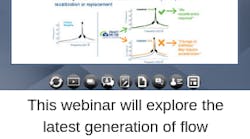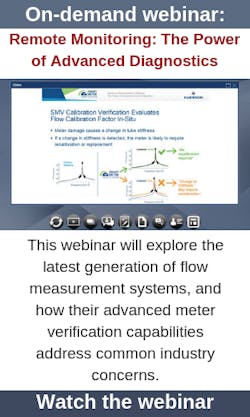Turning data into quality information for making better decisions
Taylor Scott is a former product marketing manager for Emerson’s Coriolis flow meter software products, including the Smart Meter Verification tool. Tom O’Banion currently serves as the director of global chemical application innovation for Emerson Automation Solutions, Micro Motion, Inc.
During the live Q&A portion of the webinar "Remote Monitoring: The Power of Advanced Diagnostics," Scott and O'Banion tackled several attendee questions related to instrumentation and the value of diagnostics.
PS: How do variables like viscosity, pressure, and temperature affect the meter verification?
TS: The short answer is: it depends. It depends on how stiffness is measured. When talking about the three unknowns – mass, dampening, and stiffness – we need at least three equations or three of those data points. There are some methods to measuring stiffness that only use two test frequencies. Using those two frequencies essentially requires an assumption about that third data point. Generally, that assumption is made about dampening.
Because changes in viscosity for Coriolis flow meters can affect the dampening parameter, the two-tone method can be susceptible to some false results if things like viscosity are changing. But when you're using the five-tone method, we account for and are not affected by changes in viscosity and dampening. That was proven by the testing that was done by NMi (www.nmi.nl). That testing was done under varying flow conditions, different viscosities, temperatures, and pressures. Using the five-tone method, no, the changes in things like viscosity, temperature, pressure, and flow rates do not affect stiffness measurement.
PS: When it comes to working with your customers, how ready are they for things like Smart Meter Verification, predictive maintenance, and remote monitoring?
TS: We definitely see a range. There are some customers who are a little further along in their implementation of remote monitoring strategies than others. Overall, we're definitely seeing customers progress farther and farther along and moving from sort of a strategic analysis, if you will, to actual implementation with things like connected services. I think one big thing that's helping is the growth of ethernet protocols; I think it is furthering that quite a bit.
TO: Smart Meter Verification, as an example, has a scheduling feature and a lot of our customers are not yet used to using regularly scheduled things like that. They'll go out and perform them on demand rather than have them automatically scheduled. So there is some education around some of the tools that exists.
PS: The Smart Meter Verification alert provides notification of a problem approximately twice as fast as operator identification. What parameters or workflow processes does a technician use to determine the problem?
TO: There was a rather unique situation in which a laboratory setup was created to intentionally corrode a meter. The whole challenge of the study was to corrode the meter at a controlled rate so that they could get a sense of early detection. This is actually ultimately for SIS applications. For a particularly hazardous service, anything extremely corrosive, or any process where there are known to be upsets, the customer will have Smart Meter Verifications scheduled to run frequently, perhaps even weekly. When it approaches or exceeds the acceptance limits, the transmitter will send an alert that the meter has failed Smart Meter Verification and a closer examination is suggested.

